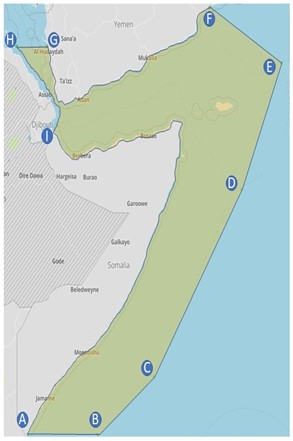Drop in Indian Ocean Piracy Prompts Reduction in High Risk Area Map
Once considered the most dangerous area on the globe for mariners, the High Risk Area (HRA) for piracy in the Indian Ocean is being reduced under an agreement with the global shipping industry. The changes reducing the geographic boundaries were set by the leading shipping organizations reflecting a continued downward trend in Somali piracy and the effective international protection efforts and methods adopted by the shipping industry.
The HRA was created at the height of the Somali piracy threat in 2010 to show shipowners, operators, and seafarers where pirates operated and where extra vigilance was required to avoid attacks. That year, the International Maritime Bureau reported that Somali pirates hijacked 49 ships and took over 1,000 hostages.
Subsequent updates to the HRA reflected the changing nature of threats in the region, including the successful suppression of Somali pirate action. Somali pirate groups have not attacked a merchant vessel since 2017.

Redefined HRA map (BIMCO)
“The security landscape is constantly evolving, and as new security threats have emerged or intensified outside the Indian Ocean it has become clear the HRA is outdated and misleading,” said Guy Platten, ICS Secretary General. “At the height of the crisis the HRA was essential in raising awareness of the Somali pirate threat and the need to apply mitigation measures, but it has essentially served its purpose in protecting crews and vessels in the region.”
Representing the global shipping and oil industries, the trade associations BIMCO, ICS, INTERCARGO, INTERTANKO, and OCIMF, agreed to reduce the HRA boundaries to the Yemeni and Somali Territorial Seas and Exclusive Economic Zones in its eastern and southern reaches. The official reduction in the boundaries goes into effect on September 1.
Speaking as a representative of the oil shipping industry Robert Drysdale, OCIMF Managing Director explained that the adjustment to the HRA reflects the reality of the piracy threat. However, while the organizations believe the threat zone has been reduced, they cautioned that vessels and their operators should be continuing to undertake pre-transit risk assessments that take into account the latest information from both the Voluntary Reporting Area (VRA) and High Risk Area. A broader area was designated as the VRA and ships entering the area are still encouraged to report to the UKMTO to be monitored during transit and register with the Maritime Security Centre for the Horn of Africa (MSCHOA).

that matters most
Get the latest maritime news delivered to your inbox daily.
The organizations, in consultation with international partners, however, also agreed to develop a comprehensive new approach to assessing international maritime security threats to allow shipowners and operators to fully gauge the risk of voyages worldwide. They expect to complete this effort by the end of 2021.
David Loosley, BIMCO Secretary General and CEO explained, “The current form of the HRA is no longer the best way to guide maritime security risk management processes. As demonstrated with the recent security incidents in the waters around the Arabian Peninsula, we need a more granular approach to the concepts of threat and risk. The next logical step is to develop a global, threat-based concept which captures how ships of various type, size, nationality, ownership, etc. face different risk levels.”
